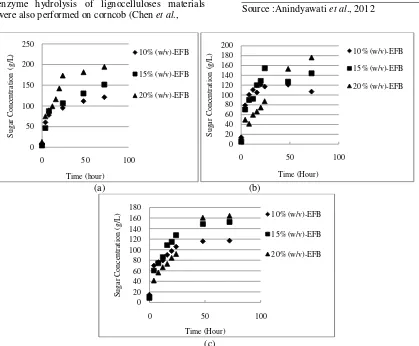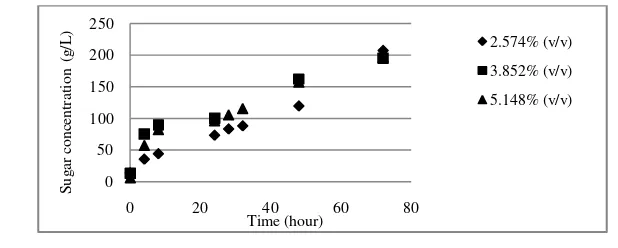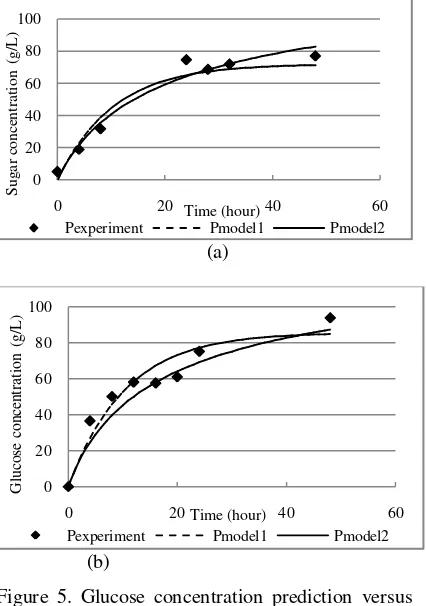Enzymatic hydrolysis of oil palm empty fruit bunch to
produce reducing sugar and its kinetic
Hidrolisis enzimatik tandan kosong kelapa sawit untuk menghasilkan gula pereduksi dan kinetikanya Vera BARLIANTI*), DelianaDAHNUM, MURYANTO, EkaTRIWAHYUNI,
YosiARISTIAWAN&YanniSUDIYANI
Research Centre for Chemistry, Indonesian Institute of Sciences (LIPI) Kawasan Puspiptek Serpong, Tangerang Selatan, Indonesia
Diterima tanggal 19 Desember 2014/disetujui tanggal 5 Maret 2015
Abstrak
Sebagai salah satu Negara penghasil minyak kelapa sawit mentah (CPO), Indonesia juga menghasilkan tandan kosong kelapa sawit (TKKS) dalam jumlah besar. TKKS terdiri dari-tiga-komponen utama, yaitu selulosa, hemiselulosa, dan lignin. Pengolahan awal TKKS secara alkalindi ikuti dengan hidrolisis TKKS secara enzimatik menggunakan kombinasi enzim selulase dan β -glukosidase akan menghasilkan gula-gula yang mudah difermentasi. Penelitian ini bertujuan untuk mempelajari pengaruh konsentrasi substrat, kon-sentrasi enzim, dan suhu selama proses hidrolisis berlangsung. Hasil yang diperoleh menunjukkan bahwa konsentrasi gula maksimum (194,78 g/L) dicapai pada konsentrasi TKKS 20% (b/v), konsentrasi campuran enzim yang terdiri dari selulase dan β-1,4 glukosidase sebesar 3,85% (v/v), dan suhu 50oC. Perbandingan antara selulase dan β-1,4 glukosidase adalah 5:1 dengan masing-masing aktivitas enzim sebesar 144.5 FPU/mL dan 63 FPU/mL. Hasil penelitian juga menunjukkan bahwa model kinetika yang sesuai untuk proses hidrolisis TKKS secara enzimatik adalah model kinetika Shen dan Agblevor dengan reakside aktivasi enzim orde satu. Hasil ini mendukung studi kelayakan ekonomi dalam pemanfaatan TKKS untuk produksi bioetanol.
[Kata kunci:Tandan kosong kelapa sawit, hidrolisis enzimatik, kinetika, selulase, gula pereduksi]
Abstract
As one of the crude palm oil producers, Indonesia also produces empty fruit bunches (EFB)in large quantities. The oil palm EFB consist of cellulose, hemicellulose and lignin. Alkaline pretreatment of EFB, followed by enzymatic hydro-lysis of cellulose using combination of cellulase and β-glucosidase enzymes produce fermentable sugars. This paper reported the effects of substrate loading, enzyme concentration, and temperature of hydrolysis process on reducing sugar production. The maximum sugar concentration (194.78 g/L)
was produced at 50oC using 20% (w/v) EFB and 3.85% (v/v) mixed enzymes of cellulase and β-1,4 glucosidase in volume ratio of 5:1 (v/v), with enzyme activity of 144.5 FPU/mL and 63 FPU/mL, respectively. The results also showed that the suitable kinetic model for enzymatic hydrolysis process of oil palm EFB follow Shen and Agblevor model with first order of enzyme deactivation. These results support the economic feasibility study in utilization of EFB of oil palm for bioethanol production.
[Key Words : Empty fruit bunch, enzymatic hydrolysis, kinetics, cellulase, reducing sugar]
Introduction
Indonesia is one of oil palm (Elaeis guineensis) producers in the world. In 2012 area of oil palm plantation reached 9.074.621 ha (Ditjenbun, 2014a) with CPO production as much as23.521.071 tons (Ditjenbun, 2014b). Along with increasing of CPO production, empty fruit bunches (EFB) as one of solid waste from palm oil mill will be available in large quantities. Treatment of one ton of fresh fruit bunchin palm oil industry will supply EFB as 0.23 ton (Yunus et al., 2010). The oil palm EFB consist of cellulose (37.62%), hemicellulose (14.62%), and lignin (31.68%). The rest are extractive materials and ash (Styarini et al., 2012). The common utilization of EFB was not maximum yet, in general EFB was used as soil mulching and co-composting with treated palm oil mill effluent (POME) in palm oil plantation (Baharuddin et al., 2009). One effort to give added value on EFB is converting cellulose (main component of EFB) to fermentable sugar that can be changed to other products easily, like bioethanol (Sun& Cheng, 2002).
Cellulose can be hydrolysed enzimatically using cellulase enzyme, a complex enzyme that consists of exocellulase or exobiohydrolase, endocellulase or endo-β-1,4-glucanase and β-1,4-glucosidase orcellobiase. Enzymatic hydrolysis process still hampered by slow reaction rate that
37
caused by compact structure of lignocellulose. The compact structure prevent enzyme penetration to active site of cellulose (Banerjee et al., 2010), therefore it is necessary to do a pretreatment process to liberate cellulose from lignocelluloses matrix. Generally, pretreatment processes were classified into physical pretreatments, chemical pretreatments, and biological pretreatments. Different type of lignocellulosic materials require different type of pretreatment process according to their characteristics. The alkaline pretreatment was effective to remove lignin and acetyl group, but the process was relatively slow. This process was suitable for biomass from herbs or agricultural residue, but not for wood with high lignin content (Banerjee et al., 2010).
The pretreated lignocelluloses still have a complex structure and composition. Actually they require the different enzymes and an appropriate condition for complete hydrolysis. Therefore it was needed to simplify analysis of effective enzymatic hydrolysis on different operation condition, and studying the hydrolysis reaction kinetics was the answer to meet the needs.
Based on fundamental approach and metho-dology, kinetic models of lignocelluloses hydro-lysis were classified to four classes namely empirical models, Michaelis-Menten based models, models accounting for adsorption, and models developed for soluble substrates (Bansal et al., 2009). Some research of this topics were hydro-lysis kinetic of food waste based on adsorption mechanism (Kim et al., 2005), hydrolysis kinetic of lignocelluloses based on fractal kinetic analysis (Yao et al., 2011), and so on.
This paper reported the effects of substrate loading (percentage of oil palm EFB in a given reaction volume), reaction temperature, and enzyme concentration on hydrolysis process of EFB to produce reducing sugar and its kinetic. The EFB had been pretreated using 10% of sodium determined by triplicates data using standard Biomass Analytical Procedures methods provided by National Renewable Energy Laboratory (NREL).
Enzymes used in hydrolysis of lignocelluloses were cellulase and β-1,4, glucosidase from Novozyme with enzyme ratio of 5 : 1. The activities of cellulase and β -1,4, glucosidase based on measurement were 144,5 FPU/mL and 63 FPU/mL respectively. The chemicals used in this study had analytical grade.
Pretreatment
Pretreatment process was carried out by alkaline method using 10% of sodium hydroxide solution. The process was held at 150oC and 4-7 kg/cm2 for 30 minutes. As much as50 kg of EFB were fed into the reactor containing 250 L of sodium hydroxide solution. At the end of process, EFB were separated from liquid by belt press separation. The next step was washing of EFB by tap water in washing tank hydrolyzed and other research activities.
Enzymatic Hydrolysis
Enzymatic hydrolysis was carried out using the Erlenmeyer flasks of 500 mL with 200 mL of working volume at pH 4.8. The Erlenmeyer flasks containing of EFB substrate, enzymes, and citrate buffer was held in shaking incubator at 150 rpm. Three different concentrations of substrate (10%, 15%, and 20% (w/v)), and three different enzyme concentrations (2.574%, 3.852% and 5.148% (v/v)) were tested. The experiment was held at 32oC, 40oC, and 50oC. The sampling was done every 4 hours on first day, and every 24 hours on second and third days. Each sample was always put in boiling water for two minutes to deactivate the enzymes prior to reducing sugar concentration measurement.
an important factor in enzymatic hydrolysis of lignocellulose materials. The sugar yield showed the opposite tendency while the substrate loading increases (Figure 2). This tendency might be caused by increasing viscosity of the reaction mixture at higher substrate loading, therefore decreasing the effect of stirring and hamper the enzyme to reach the active site of cellulose. The influence of viscosity could also decrease the initial reaction rate (see Figure 1b and 1c). It was shown that at the temperature below 50oC, the initial reaction rate at 20% (w/v) of substrate loading was slower than others. Another cause was possibility of product inhibition by high sugar concentration to deactivate the enzyme activities (Musatto et al., 2008). The sugar yield determination was done with respect to the composition of pretreated EFB as seen in Table 1.
Figure 2. illustrated the positive correlation between sugar concentration and substrate loading and the negative correlation between sugar yield and substrate loading, and it was obtained an enzyme hydrolysis of lignocelluloses materials were also performed on corncob (Chen et al.,
2007), barley straw (Rosgaard, 2007), and more. Rosgaard (2007) studied the relationship between substrate loading and viscosity of the reaction. For optimizing the hydrolysis reaction of barley straw with respect to glucose concentration and glucose yield, an optimal substrate loading at the beginning of the reaction was 12.5% (w/w) DM of barley straw.
Figure 3. showed the increase of reducing sugar concentration along within creasing of hydrolysis temperature. The maximum sugar concentration was obtained at 50oC. This happened also on sugarcane bagasse hydrolysis (Mahamud & Gomes, 2012), or food waste hydrolysis (Kim et al., 2005). It showed that increasing temperature could accelerate the reaction rate by improving performance of the enzyme functions to produce reducing sugar. The best hydrolysis temperature for these enzymes was 50oC.
Source :Anindyawati et al., 2012
(a) (b)
(c)
Figure 2. Sugar concentration and yield produced at different substrate loading at 50ºC and 3.85% (v/v) of enzyme concentration.
Gambar 2. Konsentrasi dan hasil gula tereduksi yang diperoleh pada berbagai konsentrasi substrat pada suhu 50oC dan konsentrasi enzim 3.85% (v/v).
Figure 3. Effect of hydrolysis temperature on reducing sugar formation at 20% (w/v) substrate loading and 3.85% (v/v) of enzyme concentration.
Gambar 3. Pengaruh suhu hidrolisis terhadap pembentukan gula tereduksi pada konsentrasi substrat 20% (w/v) dan konsentrasi enzim 3.85% (v/v).
Figure 4. Effect of enzyme concentration on reducing sugar formation at 50oC and 20% (w/v) substrate concentration.
Gambar 4. Pengaruh konsentrasi enzim pada pembentukan gula tereduksi pada suhu 50oC dan konsentrasi substrat 20% (w/v).
Effect of enzyme concentration
The enzyme concentration variations that used in this experiment were 2.574% (v/v), 3.852% (v/v), and 5.148% (v/v). There was slightly increasing of hydrolysis rate at 3.852% (v/v) of enzymes concentration if compared to the hydro-lysis rate at 2.574% (v/v) (Figure 4). Application of 5.148% (v/v) enzyme concentration in the experiment did not change hydrolysis rate and reducing sugar concentration at the end of process. This phenomenon might be caused by product
Kinetic parameters determination
There are many kinetic models for enzymatic hydrolysis of lignocellulosic materials, some of the models based on Michaelis-Menten kinetics model, the others based on Langmuir isotherm adsorption pattern, and so on. One of kinetic modelbased on Michaelis-Menten equation is a model that
developed by Shen &Agblevor(Zhang et al., 2010). The assumption that used in this model are cellulase enzyme has a single combined effect on hydrolysis reaction of insoluble substrate to produce reducing sugar, the surface and structure of lignocellulosic materials as insoluble substrate is considered homogeneous (Shen & Agblevor, 2011), and in effective production of enzyme-substrate complex that caused by enzyme deactivation reaction (Saura, 2011).
The enzymatic hydrolysis reaction was described that enzyme is adsorbed on the active site of lignocellulosic surface to form enzyme-substrate complex via a reversible reaction. Then enzyme-substrate complex is changed to reducing sugar or enzyme deactivation. Equation 1 describe hydro-lysis reaction of EFB to produce glucose, Equation 2 and 3 illustrated kinetic models with first order and second order of enzyme deactivation reaction.
In this study, to determine kinetic parameters of enzymatic hydrolysis of EFB, the temperature and substrate loading were fixed at the best condition with the enzyme concentration were considered as variable in kinetic models. The value of kinetic parameters wasconcluded from the best curved fitting of the experimental data with Shen and Agblevor models. The term product ( ) in the equations refers to glucose concentration (main
component of reducing sugar in this study), while initial substrate ( refers to cellulose concentrate-ion (main component of EFB). The results were shown in Figure 5.
Figure 5 showed the plot of experimental data versus data values from the first model and the second model (each model refers to equation 2 and equation 3). The experimental datas were closer to the dashed line (refers to model 1 or Equation 2). The kinetic parameter values (K_M,k_cat,k_de1, and k_de2) were put in Table 2. These models also were applied on steam-exploded wheat straw hydrolysis and the selected model was the model with second order of enzyme deactivation reaction (Zhang et al., 2010).
(a)
(b)
Figure 5. Glucose concentration prediction versus experimental data at 50oC, 20% (w/v) of substrate loading, and 2.574% (v/v) of enzyme concentration (a) and 3.852% (v/v) of enzyme loading (b).
Conclusion
Substrate loading, enzyme concentration, and reaction temperature are important factors that affect effectiveness of an enzymatic hydrolysis reaction of lignocellulose materials. The highest sugar concentration was achieved on 20% (w/v) substrate loading and 3.852% (v/v) mixed enzyme of cellulase and β-1,4 glucosidaseconcentration at 50oC, but the optimal initial substrate concentration with respect to sugar yield was 18%. The kinetics of EFB hydrolysis was preferable to follow Shen and Agblevor model with first order of enzyme deactivation reaction.Economic feasibility should be studied to apply the hydrolysis method in commercial scale.
Acknowledgement
This research was funded by Insentif Riset Sistem Inovasi Nasional (SiNas) 2013 Programme, Ministry of Research and Technology, Indonesia. The authors also thanked to Mr. Azmi Aulia and Miss Chandra Dea who helped in valuable discussion and technical assistance.
References
Anindyawati T, E Triwahyuni& T Idiyanti (2012).Optimasi proses sakarifikasi tandan kosong kelapa sawit untuk bahan baku bioetanol. Dalam : Prosiding Seminar
Nasional XXI “Kimia Dalam Industri dan
Lingkungan”.Yogyakarta, 6 Desember 2012. Baharuddin AS, M Wakisaka, Y Shirai, S
Abd-Azis, NA Abdul Rahman& MA Hassan (2009). Co-composting of empty fruit bunches and partially treated palm oil mill effluents in pilot scale. Internat J Agricult Res4 (2), 69-78.
Banerjee S, S Mudliar, R Sen, B Giri, D Satpute, T Chakrabarti & RA Pandey (2010). Commercializing lignocellulosic bioethanol : technology bottlenecks and possible remedies. Biofuels Bioprod Bioref 4, 77-93.
Bansal P, M Hall, MJ Realff, JH Lee & AS Bommarius (2009). Modelling cellulose
kinetics on lignocellulosic substrates. Biotechnol Adv 27, 833-848.
Chen M, L Xia&P Xue (2007).Enzymatic hydrolysis of corncob and ethanol production from cellulosic hydrolysate. Int Biodeter Biodegr 59, 85-89.
Ditjenbun (2014a). Luas areal perkebunan angka estimasi Tahun 2013. Diunduh dari :.http:// ditjenbun.pertanian.go.id/statis-35-luasareal. html[14 April 2014]
Ditjenbun (2014b). Produksi komoditas tanaman perkebunan angka estimasi Tahun 2013. Diunduh dari : http://ditjenbun. pertanian. go.id/ statis-36-produksi.html[14 April 2014].
Kim KC, SW Kim, MJ Kim & SJ Kim (2005). Saccharification of food wastes using cellulolytic and amylolytic enzymes from Trichoderma harzianum FJ1 and its kinetics. Biotechnol Bioprocess Engin 10, 52-59. Mahamud MR& DJ Gomes (2012).Enzymatic
saccharification of sugarcane bagasse by the crude enzyme from indigenous fungi.J Sci Res 4 (1), 227-238.
Musatto SI, G Dragone, M Fernandes, AMF Milagres& IC Roberto (2008). The effect of Agitation speed, enzyme loading, and substrate concentration on enzymatic hydrolysis of cellulose from brewer’s spent grain. Cellulose, 15, 711-721.
Rosgaard L, P Andric, KD Johansen, S Pedersen & AS Meyer (2007).Effects of substrate loading on enzymatic hydrolysis and viscosity of pretreated barley straw. Appl Biochem Biotechnol 143, 27-40.
Saura AS (2011). Modeling and analysis of enzymatic hydrolysis of lignocelluloses substrates. Thesis. KTH Chemical Science and Engineering, Stockholm, Sweden, p. 32-34.
Parameter Symbol Equation 2 Equation 3 equilibrium
constant
(g/L) 30.8597 27.3084 constant of product
formation
(h-1) 0.0842 0.0793 constant of enzyme
deactivation.
(h-1) 0.1001 -
(L/h.g) - 0.0068
Table 2. Parameter values of EFB hydrolysis based on Shen and Agblevor kinetic model. Table 2.Nilai parameter hydrolysis TKKS berdasarkan model kinetika Shen dan Agblevor.
Shen J & AF Agblevor (2011).Optimization of enzyme loading and hydraulic time in hydrolysis of mixture of cotton gin waste and recycled paper sludge for the maximum profit rate.Biochem Engin J 41, 241-250.
Styarini D, L Risanto, Y Aristiawan& Y Sudiyani (2012).Comparison of two analytical methods for compositional analysis of lignocellulosic biomass for bioethanol production. Internat J Environment and Bioenergy 3(2), 88-97. Sun Y& J Cheng (2002). Hydrolysis of
lignocellulosic materials for ethanol production: a review. Bioresource Technol83,1-11.
Yao MJ, ZL Wang, ZQ Wu& HS Qi (2011).Evaluating kinetics of enzymatic saccharifi-cation of lignocellulose by fractal kinetic analysis.Biotechnol Bioprocess Engin 16, 1240-1247.
Yunus R, SF Salleh, N Abdullah & DRA Biak (2010). Effect of ultrasonic pretreatment on low temperature acid hydrolysis of oil palm empty fruit bunch. Biores Technol 101(24), 9792-9796.
Zhang Y, JL Xu, HJ Xu, ZH Yuan & Y Guo (2010).Cellulase deactivation based modeling of enzymatic hydrolysis of steam-exploded wheat straw. Biores Technol 101, 261-826.



